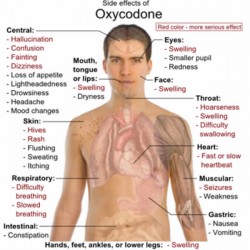Oxycodone Abuse
Understanding Oxycodone Abuse
Oxycodone is a powerful opiate that is commonly prescribed to patients who suffer from chronic pain, serious injury or illness which results in pain such as cancer. This medication treats moderate to severe pain but not without potential for worry or harm; Oxycodone is often abused leading to addiction and physical dependence which is difficult to overcome.
According to the Connecticut Department of Consumer Protection, “left untreated, oxycodone addiction is highly damaging—both to the user’s physical body as well as their overall sense of well-being.” As such, it’s important to understand the dangers of Oxycodone abuse, to learn how to recognize the signs and symptoms of abuse and to realize that there are treatment options available to those who are addicted.
Who’s at Risk for Oxycodone Abuse?
According to recent studies, Oxycodone abuse affects the lives of those both young and old alike. In fact, seniors are at risk because they tend to take more medications than younger adults or teens but teens are also falling into the perils of Oxycodone addiction. According to the Prescription Monitoring Program, “the largest increase of prescription drug use for non-medical users is among people between the ages of twelve to twenty five.” Unfortunately, anyone who takes Oxycodone, either as prescribed or for recreational purposes is at risk of falling into the downward spiral of oxycodone abuse and addiction.
Dangers of Oxycodone Abuse
According to the National Drug Intelligence Center, “individuals who abuse Oxycodone risk developing tolerance for the drug, meaning they must take increasingly higher doses to achieve the same effects.” Upon becoming addicted to oxycodone, the user will experience withdrawal symptoms that make quitting a difficult task.
As tolerance increases, the user will likely take higher doses of the drug or begin to take the drug more often which can increase the risk of overdose. Oxycodone overdose may be fatal if left untreated. People who take excessive doses of this drug are at risk of developing respiratory complications including severe respiratory depression which could cause death.
Injection of Oxycodone poses additional risks for users. Such use can cause exposure to diseases including:
- HIV
- Hepatitis B and C
- Blood borne viruses
- Infections
Effects of Oxycodone
A number of long term effects of oxycodone can wreak havoc on the user’s life if the drug use continues and is not treated. Some of the most common effects of Oxycodone include:
- labored breathing
- allergic reaction
- light-headedness
- fainting
- stomach pain
- nausea
- vomiting
- diarrhea
- jaundice
- dizziness
- drowsiness
- liver and kidney damage
- organ failure
- tolerance
- dependence
Signs of Oxycodone Abuse

These oxycodone side effects become even more severe when the drug is abused.
Oxycodone abuse often begins with being legitimate prescribed the medication for the treatment of pain following injury or illness. According to the National Library of Medicine, “prescriptions for Oxycontin can be easily obtained in clinics by presenting appropriate complaints.” Physicians are not trained to recognize the signs of a drug-seeking abuser and therefore often overlook patients who come to them in search of Oxycodone when they don’t legitimately need the drug. As such, patients are often prescribed this medication when they do not even have a legitimate reason to take the meds.
Oxycodone abusers often exhibit the following characteristics:
- “doctor-shopping” in an effort to get their hands on more drugs by seeking prescriptions from multiple doctors
- “pharmacy-hopping” as they go to different pharmacies in different areas in an effort to hide the fact that they are obtaining multiple prescriptions
- fraudulent activity including forging prescriptions, forging medical documents or altering documents to their advantage
- theft including stealing prescriptions from others, burglarizing or robbing pharmacies or stealing prescription pads from doctors
- going through extremes to take the drug including crushing and snorting the pills, injecting them, or crushing and ingesting the tablets
- risky behavior while under the influence of Oxycodone
Symptoms of Oxycodone Addiction
Much like the early signs of abuse, Oxycodone addiction signs often begin with “doctor-shopping” and other illicit attempts on the user’s part to get their hands on additional quantities of the drug. According to the Center for Substance Abuse Research at the University of Maryland, “since oxycodone products should only be used based on a doctor’s prescription, signs of addiction can be monitored and controlled more effectively than if the user is not under a physician’s care.” Unfortunately, illicit use of Oxycodone substantially increases the risk of addiction versus legitimately prescribed uses. Regardless of the method or means of use, whether for legitimate pain or for recreational purposes, Oxycodone abuse that is prolonged will, “eventually change the brain in such a way that a user cannot quit on his or her own.” This is one of the many common signs of Oxycodone addiction.
Additional signs of addiction to oxycodone include:
- feeling like you cannot live without Oxycodone
- feeling sick or uncomfortable when not under the influence of Oxycodone
- taking more oxycodone than prescribed or taking it more often than prescribed
- taking Oxycodone to cover up emotions
- taking Oxycodone to have fun or to feel good
- tolerance to the drug that requires excessive amounts of the drug in order to feel the same effects
- withdrawal symptoms when not using Oxycodone
Withdrawal from Oxycodone
Addiction to oxycodone will lead to physical dependence which often causes an array of symptoms when the individual attempts to cut back or quit using the drug. According to The National Pain Foundation, “if you suddenly stop taking opioids after taking them regularly for an extended period of time, you will experience opioid withdrawal syndrome.” The signs may include:
- sweating
- diarrhea
- vomiting
- nausea
- yawning
- weakness
- dilated pupils
- goose bumps and chills
- pain in the bone, joints and muscles
- tearing of the eyes and runny nose
- insomnia and interruptions in sleep patterns
- rapid pulse and increased blood pressure
Generally, Oxycodone withdrawal symptoms will begin six to twelve hours after the last dose and can last for a period of about 5 days. The severity of the symptoms, length of time symptoms persist and the number of symptoms that women experience generally depend on how the drug was used, how often it was used, how much was used and how long the addiction was a problem prior to the withdrawal.
Treatment for Oxycodone Addiction
Treatment for Oxycodone abuse and addiction often focuses first on helping women to stabilize and feel at ease with their withdrawal symptoms prior to providing counseling, therapy and aftercare services. According to the National Pain Foundation, “in an ideal situation, a person who wishes to discontinue use of opioids or who must discontinue use because of issues outside of their control would taper their medications under the care of his or her doctor.” Tapering Oxycodone off by reducing the dose by about 25% each day is generally an effective means at preventing serious withdrawal symptoms from occurring. Unfortunately, many addicts find it difficult to taper the dose down because this takes the control of knowing that they will take the drug but not take enough to get high—for many who are struggling with the addiction, such use without overuse can be challenging at best.
Oxycodone addiction treatment will first focus on detox followed by periods of counseling and therapy. Throughout the treatment process, the primary foundation is on supportive care for women. According to UCLA, “most conventional treatments of opiate addiction begin with detox, during which the patient is gradually tapered off the opiate while under the care of physicians who can ameliorate the symptoms of withdrawal.” For some though, oxycodone detox is too painful and difficult to go through without medical intervention and help—those who need help often utilize medication maintenance programs such as MMT to assist them in the recovery process.
Medication Maintenance
Medication maintenance programs help women who are addicted to Oxycodone by providing them with a means of coping with withdrawal and feeling at ease in recovery without having to quit “cold-turkey.” The most common method of medication maintenance for oxycodone addiction is Methadone Maintenance Treatment or MMT but Suboxone, Naltrexone, Subutex, Buprenorphine and other medications may also be used to provide similar benefits of stability, reduced withdrawal and minimized cravings.
According to Harvard Health, “more than 100,000 American addicts are now using methadone as a maintenance treatment.” This medication helps women to switch from illicit Oxycodone use and abuse to taking a daily dose of medication that helps to restore stability and balance into their lives without the upheaval and uprooting that is so commonly caused by illicit drug use. Studies estimate that, “25% of patients eventually become abstinent, 25% continue to take the drug, and 50% go on and off methadone repeatedly.”
According to the Medication-Assisted Treatment for Opioid Addiction in Opioid Treatment Programs Manual, generally methadone maintenance treatment works like this:
- patients are observed for at least one week while they are taking the dose
- continued observation for appropriate dosing takes place for at least 90 days
- the patient is permitted a take-home dose of methadone after 90 days
- urinalysis is taken once per month or more often
- assessment and counseling is provided
- education is provided
Behavioral Interventions
Various behavioral interventions may also take place when a user is in treatment for Oxycodone addiction. Contingency Management, Relapse prevention, Motivational Interviewing, Psychiatric counseling, and various other means of behavioral therapy may also take place during the treatment process to ensure patient recovery.
Many treatment programs for women are based on Motivational Incentives in which the woman is provided with an incentive or reward for completing counseling sessions, for abstaining from Oxycodone use or for other aspects of their recovery process. Combined with medical intervention, support groups such as NA and counseling that aims to provide women with a safe place where they can discuss their addiction and other elements of their life, this method of treatment can be highly effective.
Paradigm Malibu
Merriam Webster defines “Paradigm” as a theory or a group of ideas about how something should be done – a fitting definition for this unique, multifaceted treatment program for adolescents.
Details ›Journey Healing Center
Serenity and tranquility are elemental at this ultra-comfortable, luxury treatment center nestled at the base of Utah’s Wasatch Mountain Range in Sandy, Utah.
Details ›Saint Jude Retreats
A variety of treatment methods firmly rooted in sound research provide solid ground for healing at this high desert treatment center located north of Tucson.
Details ›




